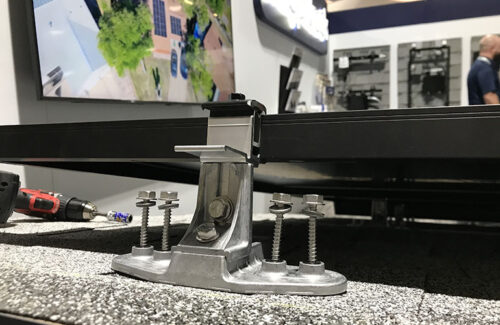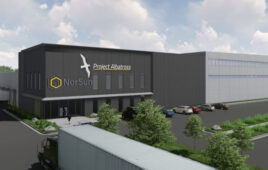Solar racking and mounting manufacturers are constantly chasing ease of use in their products. They update designs to follow installer demand and industry trends, making racks and mounts simpler to ship, handle and install.
Last year’s solar industry trade shows revealed that nearly every major single-axis tracker manufacturer solved the problem of installing solar racking on uneven terrain. This year at Intersolar North America, it’s apparent that pitched roof mounts are trending toward pre-applied adhesives like butyl. That follows a sweeping transition to smaller profile, top-mounted attachments that at first only worked on rafters and now have multiple drilling points to attach to the roof deck.
While many mounting companies have their own version of attachments with a peel-and-stick adhesive, there are a lot of new features in some of the smallest components found in residential solar construction. Here is what I saw at Intersolar.
Also, be sure to check out my storage and power electronics highlights here.
SnapNrack’s TopSpeed
As mentioned above, many smaller-profile residential mounts have the option to attach to the roof’s rafters or deck. For TopSpeed, a new mount from SnapNrack, the deck is the place to attach. Another differing feature is that TopSpeed latches to panels before reaching the roof. Two mounts are attached to a panel. The first panel row is aligned, adhesive is applied to TopSpeed, four 1/2-in. bolts are drilled into the deck at each mount and an arm protruding from the other side of the attachment aligns the following panel row.

SnapNrack’s TopSpeed solar roof mount.
SolarPod’s Z-Rack
Ballasts are a common mounting solution on commercial rooftops and ground-mounted projects where penetrating foundations are prohibited. Then there’s Z-Rack from SolarPod, a ballasted racking structure that can be installed on residential rooftops. Instead of using concrete blocks or other heavy footers, Z-Rack latches onto the peak of a pitched rooftop and uses the weight of the solar panels and the racking itself to stay in place without drilling any holes for attachment. The penetration-free racking has been wind tunnel tested for speeds up to 170 mph.

SolarPod’s Z-Rack
Pegasus Solar’s Tilt Leg
Rails often need to be cut on residential solar projects to meet a system’s design parameters. That excess rail typically ends up in the recycling bin, but Pegasus Solar devised a new attachment to turn that scrap into supports. Tilt Leg is a preassembled mount that connects to the ends of scrap rails. It’s deployed on flat rooftops and can adjust panel angles from 0 to 35°.

Pegasus Solar’s Tilt Leg
IronRidge’s Halo UltraGrip
One of these mounts using pre-applied adhesives had to be included in here. IronRidge debuted Halo UltraGrip (HUG) at Intersolar, and unlike the other mounts on the show floor this year, instead of using butyl, HUG has a combination of foam padding and mastic adhesive. The goal of partnering those two materials is to let them shape to the contours of asphalt shingles, especially those with larger protruding sediments.

IronRidge’s Halo UltraGrip






Sorry not to see you on our booth (Solar Installation Machines) at the show, Billy.
Concept:
https://www.linkedin.com/posts/nicholas-carter-phd-936b4313_stopburningstuff-electrifyeverything-activity-6951281577066721280-Y-D5?utm_source=linkedin_share&utm_medium=member_desktop_web
Prototype:
https://www.linkedin.com/posts/nicholas-carter-phd-936b4313_stopburningstuff-electrifyeverything-activity-6953201605764665344-D-n3?utm_source=linkedin_share&utm_medium=member_desktop_web